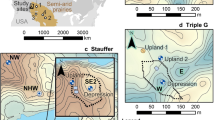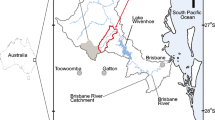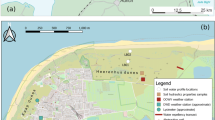Abstract
Understanding sources and rates of recharge to the Badain Jaran Desert in northern China is important for assessing sustainability of the area’s oasis lake ecosystem and its water resources in general. For this purpose, direct recharge was investigated with the chloride mass balance method for 18 unsaturated zone profiles (6–16 m depth). Spatial variability is low across the area (range in mean Cl in profiles: 62–164 mg/L Cl), largely attributable to the uniformity of sandy unsaturated zone conditions. No strong correlations between environmental factors of profile locations and recharge rates were found, though a weak relationship between recharge and vegetation density was suggested. The study area’s complex dune morphology appears to have no measurable impact on recharge variability. Mean estimated diffuse recharge is 1.4 mm/year (1.0–3.6 mm/year for 95% confidence level), approximately 1.7% of mean annual precipitation. Temporal fluctuations in recharge due to climate variability are apparent and there is good correspondence in temporal trends over a time span of 200–300 years. Water balance considerations indicate that direct recharge is insufficient to support the numerous perennial lakes in the study area, suggesting that diffuse recharge presently plays a minor role in the overall water balance of the desert’s shallow Quaternary aquifer.
Résumé
Comprendre les origines et les taux de la recharge du désert de Badain Jaran dans le Nord de la Chine est important pour estimer la durabilité des écosystèmes de la zone, écosystème de lacs et d’oasis, et ses ressources en eau en générale. Pour cela, la recharge directe a été étudiée via la méthode de la balance des chlorures sur 18 profils de la zone non-saturée (6–16 m de profondeur). La variabilité spatiale est faible sur la zone d’étude (Le Cl moyen par profil variant de 62–164 mg/L), variabilité largement attribuée à l’uniformité de l’environnement sableux de la zone non-saturée. Des corrélations fortes entre les facteurs environnementaux localisés autour des profils et les taux de recharge n’ont pas été trouvés, tandis qu’une relation faible entre la densité de la recharge et la végétation est suggérée. La morphologie dunaire complexe semble avoir un faible impact sur la variabilité de la recharge. La recharge diffuse moyenne est de 1.4 mm/a (1.0–3.6 mm/a avec un intervalle de confiance de 95%), soit approximativement 1.7% de la précipitation moyenne annuelle. Les fluctuations temporaires de la recharge, dues à la variabilité climatique sont apparentes et il existe une bonne tendance temporaire sur une période de 200–300 ans. Les considérations sur la balance en eau indiquent que la recharge directe est insuffisante pour supporter les nombreux lacs permanents de la zone d’étude, suggérant que la recharge diffuse actuelle joue un rôle mineur dans la balance en eau globale de l’aquifère phréatique Quaternaire.
Resumen
Comprender las fuentes y tasas de recarga en el Desierto de Badain Jaran, en el norte de China, es importante para la sostenibilidad del ecosistema del oasis lacustre y sus recursos de agua en general. Con este propósito, la recarga directa fue investigada con el método del balance de masa de cloruro en 18 perfiles en zona no-saturada (6–16 m de profundidad). La variabilidad espacial es baja a través del área (intervalo de Cl promedio en los perfiles: 62–164 mg/L Cl), mayormente atribuible a la uniformidad de condiciones arenosas en la zona no-saturada. No se encontraron correlaciones fuertes entre los factores ambientales en los sitios de los perfiles y las tasas de recarga, aunque los resultados sugieren una relación débil entre recarga y densidad de vegetación. La compleja morfología de duna en el área de estudio parece no tener impacto medible sobre la variabilidad de recarga. La recarga difusa promedio estimada es 1.4 mm/año (1.0–3.6 mm/año para el 95% de nivel de confianza), aproximadamente el 1.7% de la precipitación media anual. Las fluctuaciones temporales en la recarga debidas a variabilidad del clima son aparentes y hay una buena correspondencia en patrones temporales en un periodo de 200–300 años. Consideraciones del balance hídrico indican que la recarga directa es insuficiente para explicar los numerosos lagos perennes en el área de estudio, sugiriendo que la recarga difusa juega actualmente un papel menor en el balance hídrico total del acuífero Cuaternario somero del desierto.













Similar content being viewed by others
References
Allison GB, Hughes MW (1978) The use of environmental tritium and chloride to estimate total recharge to an unconfined aquifer. Australian J Soil Sci 16:181–195
Allison GB, Stone WJ, Hughes MW (1985) Recharge in karst and dune elements of a semi-arid landscape by natural isotopes and chloride (Murray Basin, Australia). J Hydrol 76(1–2):1–25
Allison GB, Cook PG, Barnett SR, Walker GR, Jolly ID, Hughes MW (1990) Land clearance and river salinisation in the western Murray Basin, Australia. J Hydrol 119:1–20
An C, Feng Z, Barton L (2006) Dry or humid? Mid Holocene humidity changes in arid and semi-arid China. Quat Sci Rev 25(3–4):351–361
Boulton AJ, Humphreys WF, Eberhard SM (2003) Imperilled subsurface waters in Australia: biodiversity, threatening processes and conservation. Aquat Ecosyst Health Manage 6(1):41–54
Brunner P, Bauer P, Eugster M, Kinzelbach W (2004) Using remote sensing to regionalize local precipitation recharge rates obtained from the Chloride Method. J Hydrol 294(4):241–250
Chen JS, Li L, Wang JY, Barry DA, Sheng XF, Gu WZ, Zhao X, Chen L (2004) Groundwater maintains dune landscape. Nature 432:459–460
Cook PG, Edmunds WM, Gaye CB (1992) Estimating paleorecharge and paleoclimate from unsaturated zone profiles. Water Resour Res 28(10):2721–2731
de Vries JJ, Simmers I (2002) Groundwater recharge: an overview of processes and challenges. Hydrogeol J 10(1):5–17
Dettinger MD (1989) Reconnaissance estimates of natural recharge to desert basins in Nevada, USA, by using chloride balance calculations. J Hydrol 106(1–2):55–78
Domros M, Peng G (1988) The climate of China. Springer Netherlands, Dordrecht, The Netherlands
Dong Z, Wang T, Wang X (2004) Geomorphology of the megadunes in the Badain Jaran Desert. Geomorphology 60(1–2):203
Dyck MF, Kachanoski RG, de Jong E (2005) Spatial variability of long-term chloride transport under semiarid conditions. Vadose Zone J 4:915–923
EANET (2006) EANET data on the acid deposition in the East Asian region. Acid Deposition and Oxidant Research Center, Niigata-shi, Japan. http://www.eanet.cc. Cited 15 Feb 2007
Edmunds WM, Gaye CB (1994) Estimating the spatial variability of groundwater recharge in the Sahel using chloride. J Hydrol 156(1–4):47–59
Edmunds WM, Darling WG, Kinniburgh DG (1988) Solute profile techniques for recharge estimation in semi-arid areas and arid terrain. In: Simmers I (ed) Estimation of natural groundwater recharge. Reidel, Dordrect, The Netherlands, pp 139–157
Edmunds WM, Fellman E, Goni IB, Prudhomme C (2002) Spatial and temporal distribution of groundwater recharge in northern Nigeria. Hydrogeol J 10(1):205–215
Edmunds WM, Ma J, Aeschbach-Hertig W, Kipfer R, Darbyshire F (2006) Groundwater recharge history and hydrogeochemical evolution in the Minqin Basin, north west China. Appl Geochem 21(12):2148–2170
Favreau G, Leduc C, Marlin C, Dray M, Taupin JD, Massault M, La Salle CL, Babic M (2002) Estimate of recharge of a rising water table in semiarid Niger from H-3 and C-14 modeling. Ground Water 40:144–151
Feng Q, Liu W, Su YH, Zhang YW, Si JH (2004) Distribution and evolution of water chemistry in Heihe River basin. Environ Geol 45:947–956
Gieske A, Selaolo E, McMullen S (1990) Groundwater recharge through the unsaturated zone of southeastern Botswana: a study of chloride and environmental isotopes. IAHS Publ no. 191, IAHS, Wallingford, UK, pp 33–44
Goni IB, Fellman E, Edmunds WM (2001) Rainfall geochemistry in the Sahel region of northern Nigeria. Atmos Environ 35(25):4331–4339
Hayashi M, van der Kamp G, Schmidt R (2003) Focused infiltration of snowmelt water in partially frozen soil under small depressions. J Hydrol 270:214–229
Heilweil V, Solomon K (2004) Millimeter- to kilometer-scale variations in vadose-zone bedrock solutes: implications for estimating recharge in arid settings. In: Hogan JF, Phillips F, Scanlon BR (eds) Groundwater recharge in a desert environment: the southwestern United States. American Geophysical Union, Washington, DC, pp 49–67
Hofmann J (1996) Lakes in the SE part of Badain Jaran Shamo, their limnology and geochemistry. Geowissenschaften 14(7–8):275–278
Hofmann J (1999) Geoökologische Untersuchungen der Gewässer im Südosten der Badain Jaran Wüste [Geoecological studies of the waters of the southeastern Badain Jaran Desert]. Berliner Geograph Abhandl 64:1–247
Jäkel D (1996) The Badain Jaran Desert: its origin and development. Geowissenschaften 7–8:272–274
Jäkel D (2002) The importance of dunes for groundwater recharge and storage in China. Z Geomorph NF Suppl 126:131–146
Jäkel D (2004) Initial stages of complex duneforms after rainfall and formation processes of honeycomb and kettle dunes in the Badain Jaran Desert (Shamo) in China. Z Geomorph NF Suppl 133:107–128
Johnston C (1987) Preferred water flow and localized recharge in a variable regolith. J Hydrol 94:129–142
Keese KE, Scanlon BR, Reedy RC (2005) Assessing controls on diffuse groundwater recharge using unsaturated flow modeling. Water Resour Res 41(6):W06010
Lundin LC (1990) Hydraulic properties in an operational model of frozen soil. J Hydrol 118:289–310
Ma J, Edmunds WM (2006) Groundwater and lake evolution in the Badain Jaran desert ecosystem, Inner Mongolia. Hydrogeol J 14(7):1231–1243
McCord JT, Stephens DB (1987) Lateral moisture flow beneath a sandy hillslope without an apparent impeding layer. Hydrol Process 1:225–238
Mischke S, Demske D, Wünnemann B, Schudack M (2005) Groundwater discharge to a Gobi desert lake during Mid and Late Holcene dry periods. Palaeogeogr Palaeoclimatol Palaeoecol 225(1–4):157–172
Murphy EM, Ginn TR, Phillips JL (1996) Geochemical estimates of paleorecharge in the Pasco Basin: evaluation of the chloride mass balance technique. Water Resour Res 32(9):2853–2868
Petheram C, Walker G, Grayson R, Thierfelder T, Zhang L (2002) Towards a framework for predicting impacts of land-use on recharge: 1. a review of recharge studies in Australia. Aust J Soil Res 30(3):397–417
Phillips F (1994) Environmental tracers for water movement in desert soils of the American Southwest. Soil Sci Soc Am J 58:14–24
Prych EA (1998) Using chloride and chlorine-36 as soil-water tracers to estimate deep percolation at selected locations on the US Department of Energy Hanford Site, Washington. US Geol Surv Water Suppl Pap 2481
Scanlon BR (1991) Evaluation of moisture flux from chloride data in desert soils. J Hydrol 128(1–4):137–156
Scanlon BR, Goldsmith RS (1997) Field study of spatial variability in unsaturated flow beneath and adjacent to playas. Water Resour Res 33(10):2239–2252
Scanlon BR, Keese K, Reedy RC, Simunek J, Andraski BJ (2003) Variations in flow and transport in thick desert vadose zones in response to paleoclimatic forcing (0–90 kyr): field measurements, modeling, and uncertainties. Water Resour Res 39:1179. DOI 1110.1029/2002WR001604
Scanlon BR, Reedy RC, Stonestrom DA, Prudic DE, Dennehy KF (2005) Impact of land use and land cover change on groundwater recharge and quality in the southwestern USA. Glob Chang Biol 11:1577–1593
Selaolo E, Gieske A, Beekman H (1994) Chloride deposition and recharge rates for shallow groundwater basins in Botswana. Paper presented at Water Down Under 94, Institute of Engineers, Adelaide, Australia, November 1994, vol 2(B), pp 501–506
Sharma M, Hughes MW (1985) Groundwater recharge estimation using chloride, deuterium and oxygen-18 profiles in the deep coastal sands of Western Austrialia. J Hydrol 81(1–2):93–109
Sophocleous M (1992) Groundwater recharge estimation and regionalization: the Great Bend Prairie of central Kansas and its recharge statistics. J Hydrol 137(1–4):113–140
Stahli M, Jansson PE, Lundin LC (1996) Preferential water flow in a frozen soil: a two-domain model approach. Hydrol Process 10:1305–1316
Stone WJ (1992) Paleohydrologic implications of some deep soil water chloride profiles, Murray Basin, South Australia. J Hydrol 132:201–223
Tyler SW, Chapman JB, Conrad SH, Hammermeister DP, Blout DO, Miller JJ, Sully MJ, Ginanni JM (1996) Soil-water flux in the southern Great Basin, United States: temporal and spatial variations over the last 120 000 years. Water Resour Res 32(6):1481–1499
Walvoord MA, Phillips FM (2004) Identifying areas of basin-floor recharge in the Trans-Pecos region and the link to vegetation. J Hydrol 292(1–4):74
Yan M, Wang S, Li B, Dong G (2001) Formation and growth of high megadunes in Badain Jaran Desert. Acta Geogr Sin 56:83–91
Yang X, Williams MAJ (2003) The ion chemistry of lakes and late Holocene desiccation in the Badain Jaran Desert, Inner Mongolia, China. Catena 51(1):45–60
Zhang H, Peng J, Ma Y, Chen G, Feng Z, Li B, Fan H, Chang F, Lei G, Wünnemann B (2004) Late Quaternary palaeolake levels in Tengger Desert. Palaeogeogr Palaeoclimatol Palaeoecol 211(1–2):45–58
Zhao LT, Gray DM (1997) A parametric expression for estimating infiltration into frozen soils. Hydrol Process 11:1761–1775
Acknowledgements
The research is supported by the National Science Foundation of China (No. 40671029), the Dudley Stamp grants programme of the Royal Society, and a postgraduate research grant from the British Society for Geomorphology. This work also forms part of a wider UK-China collaboration and we acknowledge the support of the Royal Society through its link scheme (PEK/0992/306). The authors would like to thank H. Tianming, L. Xianghu and D. Zhenyu for field and laboratory support, and P. Renard, S. Yonghong, I. Cartwright and an anonymous reviewer for helpful comments on the manuscript.
Author information
Authors and Affiliations
Corresponding author
Rights and permissions
About this article
Cite this article
Gates, J.B., Edmunds, W.M., Ma, J. et al. Estimating groundwater recharge in a cold desert environment in northern China using chloride. Hydrogeol J 16, 893–910 (2008). https://doi.org/10.1007/s10040-007-0264-z
Received:
Accepted:
Published:
Issue Date:
DOI: https://doi.org/10.1007/s10040-007-0264-z




